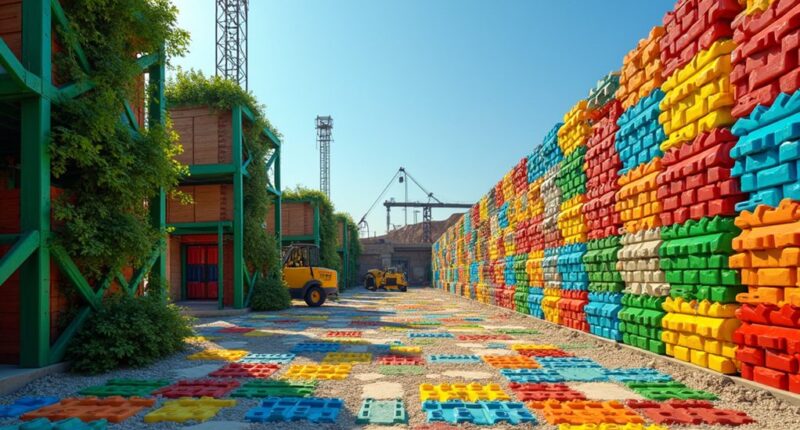By 2025, Canadian construction is poised to turn the tide on plastic waste, transforming it into innovative building materials that embody the principles of the circular economy. With 80% of construction plastics being clean and divertible, creative solutions like modular techniques and reclaimed materials are leading the charge. These advancements not only minimize landfill overflow but also promote sustainability across the sector. It’s a game changer inviting everyone to rethink waste as a resource; stay tuned for more exciting developments!
Quick Overview
- Canadian construction is adopting circular economy practices to transform plastic waste into valuable building materials, reducing reliance on fresh resources.
- Innovations like modular construction and adaptive reuse are extending building life cycles and minimizing plastic waste in the construction sector.
- Government initiatives, including the National Strategy for remanufacturing, promote sustainable practices and foster collaboration among industry stakeholders.
- The Canadian Circular Economy Summit 2025 will showcase successful circular economy practices and drive momentum for sustainable construction solutions.
- Knowledge-sharing hubs and demonstration projects will enhance skills and facilitate the implementation of circularity in the construction industry.
The Current State of Plastic Waste in Canadian Construction
In the bustling world of Canadian construction, plastic waste is emerging as a heavyweight contender in the environmental arena, and it’s not the kind of heavyweight anyone wants to see on the scale.
The industry churns out an astonishing 1.1–2.7 kg of plastic per square meter, especially from institutional and residential projects. A major hospital project can produce a jaw-dropping 700 tonnes of plastic waste—imagine 140 million plastic bags! Unfortunately, tracking this waste is a mess, with inconsistent reporting and a lack of standard practices. Approximately 80% of construction plastics are clean packaging and divertible, highlighting the potential for better waste management. The environmental consequences of plastic pollution extend far beyond the construction site, affecting ecosystems and wildlife for generations. Additionally, much of this plastic often ends up in landfills due to poor waste management practices. Without better management, much of this plastic ends up in landfills, not recycling bins.
Innovations Driving Circular Economy Practices
Innovations in circular economy practices are like an invigorating change in the often-stuffy world of construction, challenging the industry to rethink its relationship with plastic waste.
Recovered materials, like wood and plastics, find new life in projects, reducing the need for fresh resources.
Adaptive reuse projects repurpose buildings, promoting longevity over landfill.
Modular construction techniques make retrofitting a breeze, extending life cycles while slashing waste. Cross-laminated timber has emerged as a leading sustainable material for modular building systems due to its lower carbon footprint compared to traditional materials. With government funding backing these initiatives, Canada’s construction sector is not just building structures; it’s sculpting a sustainable future, proving that recycling isn’t just for bottles—it’s for buildings, too.
In fact, the construction sector currently accounts for 40% of global GHG emissions, highlighting the urgent need for sustainable practices. This is especially relevant as Canada’s plastic waste represents a $8 billion lost opportunity according to 2016 estimates.
Who knew construction could be so clever?
Collaborative Efforts and Future Directions
As the construction industry embraces the necessity of a circular economy, collaborative efforts are emerging as the backbone of this transformation.
Federal initiatives, like the National Strategy for remanufacturing, work hand-in-hand with municipal partnerships, creating a vibrant ecosystem for sustainable practices. The Global Alliance on Circular Economy provides crucial support in driving these initiatives forward. Additionally, the Canadian Circular Economy Summit 2025 showcased best practices and solutions, further fueling collaboration among stakeholders.
Workshops and summits unite diverse stakeholders, breaking down barriers with a dash of teamwork.
Knowledge-sharing hubs and educational programs enhance skills, making circularity not just a buzzword but a movement.
Meanwhile, demonstration projects serve as playgrounds for innovation, showcasing real-world applications.
These initiatives focus on continuous reuse of materials, fundamentally changing how we view waste in construction processes.
Together, these efforts paint a hopeful picture for a future where plastic waste becomes valuable building blocks instead of burdens.









